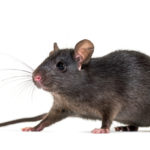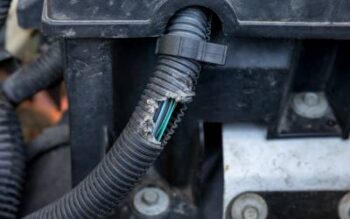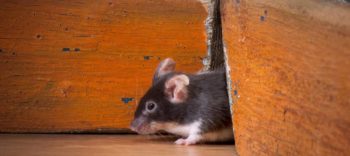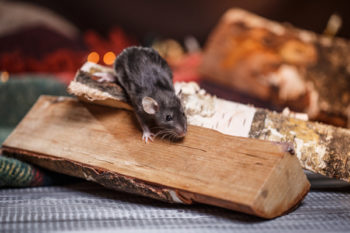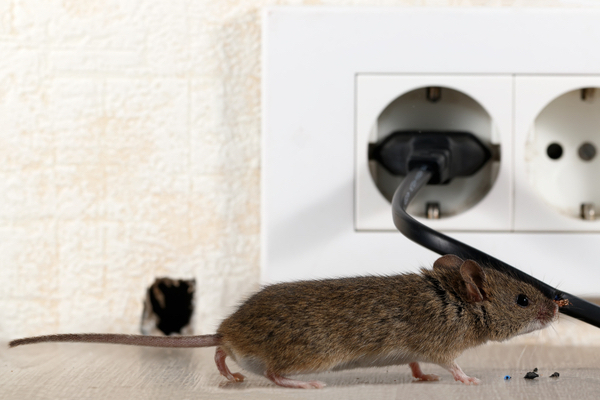
All of the signs of mice in your home stem from different mouse needs. Mice sharpen their teeth on soft material, leaving behind gnaw marks. They leave droppings wherever they nest. They’ll damage containers to access food. Understanding mice needs helps you spot the signs of mice in your home.
Spotting signs of mice in your home is important because, in turn, the faster you spot them, the faster you can intercept and end possible mouse infestations before they get out of hand. Mice tend to reproduce indoors rather quickly, so you’ll have to act fast! Here are each of the common signs of mice in your home to watch out for, what they mean, and what you should do about them:
Droppings
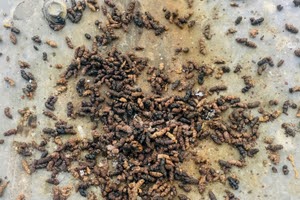
Mouse droppings are dark brown or black, around ¼ to ½ an inch long, and shaped like a thin spindle, pill, pellet, or thin grain of rice. They usually look and feel dry and brittle. As droppings dry, they flake and break apart, which will make them look like dirt.
A single mouse can produce up to 1% of its weight in droppings in a single day. Mice tend to poop in straight lines because they follow set pathways to navigate through your home safely. Look for straight lines of rice-shaped droppings around baseboarding, wall corners, and under furniture. The more droppings you find, the more mice you probably have.
Gnaw Marks & Damaged Wiring
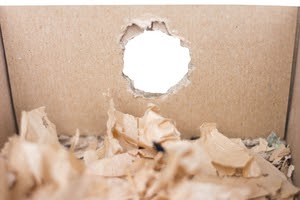
Rodent incisors never stop growing. To compensate, mice have to teethe throughout their lives. They’re constantly gnawing on any soft material they can find, including wood, paper, cloth and other fabrics… and, unfortunately, electrical wiring. Over time, mice can leave behind distinctive gnaw marks on this material and even begin to cause dangerous damage.
Mice generally gnaw on soft materials at night, around where they nest and hide during the day. Look for damaged wires, chewed cardboard and other paper products, torn up fabric and furniture, ruined insulation, and gnawed wood, especially in any unfinished parts of your home such as your basement or crawl space. If you find damaged wiring, give us a call right away!
Damaged Food Containers
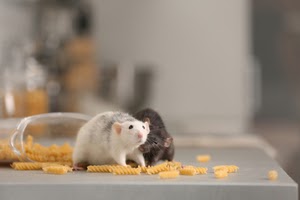
Mice need to eat. That means if mice are going to stay inside your home for any extended period of time, they have to eat inside your home, too. Mice are omnivorous and notoriously interested in quantity rather than quality. They’re even more interested in consistency. Mice want a food source they can return to time and time again.
Consequently, mice love to break into packaged food – particularly packaged food that you don’t use or deplete very quickly. Look for damaged dry goods such as bird seed, pet food, flour, nuts, seeds, and anything else you keep in dry storage. Mice dig their way inside food containers and help themselves as long as they can. The trick to keeping them from living near you perpetually is to make sure that isn’t long.
Nests
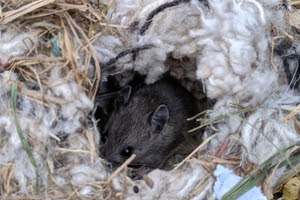
Rodent nests aren’t exactly as elaborate as the bird’s nests you’re used to associating with the word. In fact, they probably won’t look “nest-like” at all. Mice build small nests out of any reclaimed soft material they’ve gnawed away. This could include paper, insulation, fabric, or pretty much any other scraps of garbage they can (literally) sink their teeth into.
Mice are nocturnal and spend most of their time sleeping or hiding in dark, sheltered areas. These areas also tend to be where they build their nests and raise their young. Look for small, dirty clumps of soft debris under furniture, in underutilized corners, under racks and shelving, and pretty much anywhere else where mice could sneak around and hide without fear of being bothered.
Dirty Wall Markings
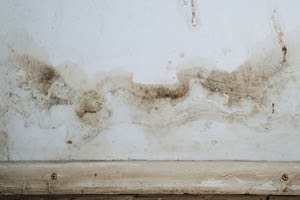
Rodents actually have very poor eyesight. In order to move around your home safely, they tend to stick to paths they know, running their bodies along a wall or object to make sure they’re not lost. The longer mice stick to a particular path, the more of their body grease and dirt rubs off on the walls and objects they rub up against.
Mice generally run along the perimeter of the rooms they inhabit. Check for dark, greasy smudge marks along the baseboarding in your basement or closets. Look for fur, gnaw marks, and the other signs included on this list along the path as you follow it for more evidence of infestation.
What to Do if You Have Mice
If you find any of these… ahem… telltale signs of mice infestation in your home, then it means the time to take action is now. The longer mice live in your home, the harder they are to remove.
The best way to take action is, of course, to give Griffin Pest Solutions a call right away. Our experts specialize in mouse control that keeps the repugnant rodents away for good. Let us know whenever you need our help, and we’ll be there faster than even the most enterprising mouse could make itself at home – no ifs, ants, or bugs!
Want a quick way to reference the signs of mice in your house while you’re tracking down your mice? Keep this trusty infographic with you and you’ll always know what to look for:


